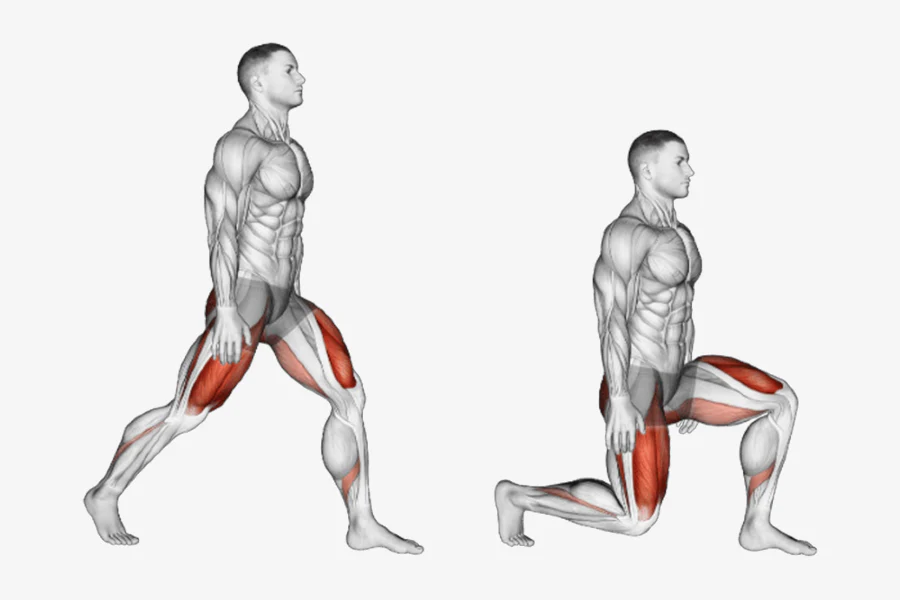ACL(anterior cruciate ligament) injuries occur when the ACL, a ligament which stabilizes the knee, is torn or sprained. This injury commonly occurs in basketball due to the sudden stops, pivots, and changes in direction. ACL injuries can occur when a player lands awkwardly from a jump, experiences a strong force to the knee, or stops too suddenly. ACL tears often cause pain, swelling, instability in the knee, limit motion, and can take athletes off the court for a while.
Prevention guide:
Strengthening the lower body muscles
Strengthening lower body muscles like quadriceps, hamstrings, and glutes enhances knee stability and lower the risk of ACL injuries.
Walking lunges
1. Stand with feet hip-width apart
2. Take a step forward with one of your legs, lowering your hips until both knees are bent at about 90 degrees
3. Push through your right heel and return to the starting position
4. Perform 2-3 sets of 10-12 reps for each leg

Romanian deadlift
1. Stand feet-shoulder length apart, holding weights in front of thighs
2. Hinge at hips, push them backward, and slightly bend your knees
3. Lower weights along legs until hamstring stretch
4. Drive hips forward, returning to the initial position.

(menshealth.com 2024)
Flexibility training
Stretching muscles reduces tension on the ACL ligament and reduces muscle tightness. This leads muscles to recover quicker and lower the probability of an ACL injury.
Standing hamstring stretch
1. Stand straight and place one of your feet forward with the heel on the ground
2. Keep your back straight and lean forward from your hips until you feel a stretch in the back of your thigh
3. Hold for 15-30 seconds and repeat 2-3 times for each side

Seated calf stretch
1. Sit on the floor with your legs straight
2. Loop a resistance band around the ball of your right foot
3. Pull the towel toward you, keeping your knee straight, until you feel a stretch in your calf
4. Hold for 15-30 seconds and repeat 2-3 times per side

(movebettergwent.nhs.wales 2024)
Iliotibial (IT) Band Stretch
1. Stand with your feet together
2. Cross your right leg over your left leg
3. Push your hips to the left until you feel a stretch on the outside of your right thigh
4. Hold for 15-30 seconds and repeat 2-3 times per side

(myhealth.alberta.ca 2024) Treatment guide:
Acute stage:
PEACE principle
Protect: Limit movement for 1-3 days to prevent further injury
Elevate: Elevate the injured leg above heart level to reduce swelling
Avoid anti-inflammatories: inflammation is a natural response of the body to injury and is a crucial part in the healing process. Therefore, refrain from using anti-inflammatories
Compress: Apply a compression bandage to control swelling
Educate: Understand the injury and recovery process to set realistic expectations
Medical evaluation
In case of severe pain, an audible pop, or heavy bruising seek medical attention for an injury evaluation.
Understanding grades of an ACL tear
Grade I (mild sprain): Grade I ACL tear involves slight stretching and microscopic tears of the ligament. The symptoms of a grade I tear are mild, including slight pain, minimal swelling, and little to no instability. With proper rest and treatment, recovery usually takes 2-4 weeks.
Grade II (partial tear): A grade II ACL tear involves more intense ligament damage, with 20-80% of the ligament fibers torn. Symptoms of a grade II ACL injury include moderate pain, noticeable swelling, bruising, and some knee instability. Usually, grade II ACL injuries take 6-8 weeks to fully recover and may need medical attention.
Grade III(complete tear): A grade III ACL injury is the complete rupture of the ligament, resulting in the loss of it's function. Symptoms include severe pain, swelling, bruising, and instability. Recovery usually takes 9-12 months. Most grade III ACL tears require surgical reconstruction.
Subacute stage:
Rehabilitation exercises
During the subacute stage of an ACL injury, the focus shifts to motion of movement, enhancing muscle strength, and improving stability.
Prone knee flexion
1. Lie on your back with legs straight.
2. Bend injured leg, bringing your heel towards the glutes
3.Hold for 5 seconds then relax
4. Repeat 10 times.

(skimble.com 2024) Bodyweight leg extensions
1. Sit on an edge
2. Place feet flat
3. Straighten injured leg
4. Hold for 2 seconds
5. Slowly lower
6. Perform 10-12 reps of 2-3 sets

(gymgeek.com 2024)
Comments